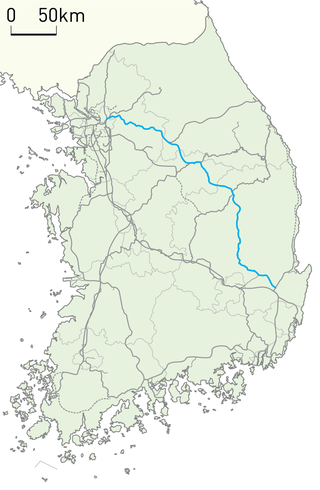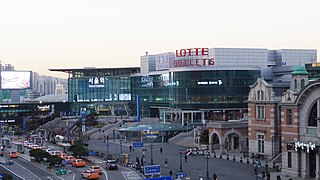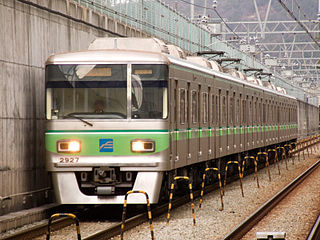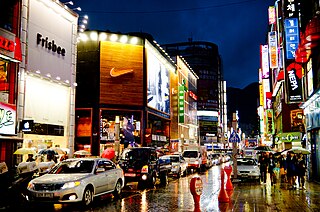
Busan, officially Busan Metropolitan City, is South Korea's second most populous city after Seoul, with a population of over 3.4 million inhabitants as of 2017. Formerly romanized as Pusan, it is the economic, cultural and educational center of southeastern South Korea, with its port being South Korea's busiest and the sixth-busiest in the world. The surrounding "Southeastern Maritime Industrial Region" is South Korea's largest industrial area. The large volumes of port traffic and urban population in excess of 1 million make Busan a Large-Port metropolis using the Southampton System of Port-City classification.

The Korea Railroad Corporation, branded as KORAIL, is the national railway operator in South Korea. Currently, KORAIL is a public corporation, managed by Ministry of Land, Infrastructure and Transportation.

The Jungang line is a railway line connecting Cheongnyangni in Seoul to Moryang in Gyeongju in South Korea, traversing central South Korea from the northwest to the southeast. It is also referred to the rail line of the Seoul Metropolitan Subway from Yongsan station to Jipyeong station. The section from Cheongnyangni to Dodam was designated as a semi-high-speed railway.

The Donghae Nambu Line (Korean: 동해남부선) is a railway line connecting Busan to Pohang in South Korea. The line runs along South Korea's east coast. On December 30, 2016, it was merged into Donghae Line.

The Gaya Line is a railway line of Korail in Busan Metropolitan City, South Korea, connecting Sasang on the Gyeongbu Line with Beom-il on the Donghae Line via Gaya, where the line also connects to the Bujeon Line.
The Bujeon Line is a short railway line serving Busan, South Korea. The line connects Gaya on the Gaya Line to Bujeon on the Donghae Nambu Line, without intermediary stops. It is roughly 2.2 kilometers in length.

Seoul Station (Korean: 서울역) is a major railway station in Seoul, the capital of South Korea. The station is served by the Korail Intercity Lines and the commuter trains of the Seoul Metropolitan Subway.

Busan Metro Line 1 is the north-south route of the Busan Metro. It is 40.4 kilometres (25.1 mi) long with 40 stations, and is considered the second longest line of the Busan Metro system, just behind Line 2. But with Line 1 going to regions such as Jagalchi Station, Busan Station, Seomyeon Station, Dongnae Station, and Nopo Station, it is deemed the most popular line of all of the Busan Metro system. Line 1 uses 8-car trains. The line color is orange. Its station signs are circular with a white face and orange frame, boasting the name of the station in Korean in big Hangul letters with the smaller English name below it with the station number in orange beside it and the Hanja name at the bottom of their face in similar-sized font. Unlike in the other stations, Line 1's station signs typically lack arms sprouting from their sides, even on the outer walls; instead, the neighboring stations are printed on a black strip that runs across the outer wall; some exceptions exist as in Seomyeon station, where the signs use the designs used for Lines 3 and 4, albeit with an orange frame.

The Yeongdong Line is a line of Korail. It connects Yeongju in North Gyeongsang Province with Gangneung in Gangwon Province. From Yeongju, it crosses the Taebaek Mountains and reaches the Sea of Japan at Donghae, thence proceeding north to Gangneung.

The Busan Metro is the urban rail system operated by the Busan Transportation Corporation of Busan, South Korea. The metro network first opened in 1985 with seventeen stations, making Busan the second city in South Korea and third in the Korean Peninsula to have a metro system. The Metro itself consists of 4 numbered lines, covering 116.5 kilometres (72.4 mi) of route and serving 114 stations. Including the BGL and the Donghae Line, the network covers 205.6 kilometres (127.8 mi) of route and serving 158 stations.

Rail transport in South Korea is a part of the transport network in South Korea and an important mode of the conveyance of people and goods, though railways play a secondary role compared to the road network. The network consists of 4,285 km (2,663 mi) of standard-gauge lines connecting all major cities with the exception of Jeju City on Jeju Island, which does not have railways; of the network, 2,790 km (1,730 mi) are double-tracked and 3,187 km (1,980 mi) are electrified. In 2018, rails carried 11.5 percent of all traffic in South Korea – 134.8 million passengers and 30.9 million tonnes of freight – with roads carrying 88.3 percent.
Seoul, the capital and largest city in South Korea, accounts for only 0.6% of the country's total land area, yet it is home to around 19% of the population. The population density in Seoul demands a great deal of the city's transportation systems, which are regarded by many as among the best and most advanced in the world. Seoul is very well connected by its subway and bus systems, and the city is also very supportive of pedestrian foot travel. In 2006 it won the Sustainable Transport Award.

Donghae Expressway is an expressway in South Korea, connecting Busan to Sokcho. It is numbered 65 and it is planned to eventually extend all the way along the east coast to Haeundae, Busan. Its current length is 62.1 kilometres (38.6 mi), and It is part of the Asia Highway Route 6.

Seomyeon Station is a station on the Busan Metro Line 1 and Line 2 located in Bujeon-dong, Busanjin District, Busan.
High-speed rail service in South Korea began with the construction of a high-speed line from Seoul to Busan in 1992, and was inspired by Japan's Shinkansen. The first commercial high-speed rail service was launched on April 1, 2004. Currently, South Korea hosts two high-speed rail operators: Korea Train eXpress (KTX) and Super Rapid Train (SRT).

Seomyeon is the commercial center and transportation hub in Busanjin-gu, Busan, South Korea. Seomyeon is also the most crowded area in Busan, having an average floating population of 1,000,000 a day.

Pohang Station is a railway station in the city of Pohang, South Korea. The station is the terminus of the Donghae Line.
Bujeon station may refer to two train stations in Busan, South Korea:

The Donghae Line is a railway line connecting Busanjin station to Yeongdeok in South Korea. The literal meaning of its name, the "East Sea Line," reflects its position along the nation's East coast. It merged with the Donghae Nambu Line on December 30, 2016, and will merge with the Donghae Bukbu Line.
Yangsan Metro is an under construction rubber-tyred metro line connecting Nopo station in Nopo-dong, Geumjeong District, Busan and Bukjeong station in Bukjeong-dong, Yangsan, South Gyeongsang Province, South Korea. Originally, it was promoted as the Nopo-Bukjeong line.



















